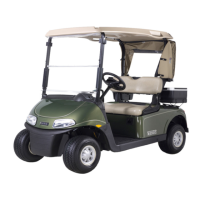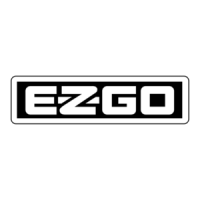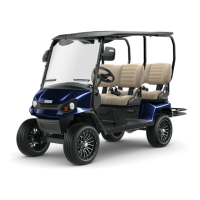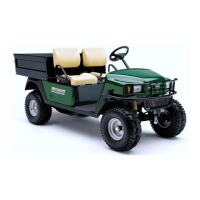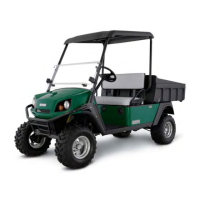Page A-5
Repair and Service Manual
B
B
GENERAL INFORMATION & ROUTINE MAINTENANCE
Read all of Section B and this section before attempting any procedure. Pay particular attention to Notices, Cautions, Warnings and Dangers.
• Properly inflate the tires to recommended pres-
sure (psi) stated on sidewall of tires.
• Place the Forward/Reverse handle in the NEU-
TRAL position and engage the neutral lock (Ref.
Fig. 4).
• Turn the Fuel Shut-Off Valve to the closed (OFF)
position.
• With proper ventilation, run engine until the
remaining fuel in carburetor and fuel lines is
depleted and the engine stalls.
• Return the neutral lock to the OPERATE position.
• Loosen, but do not remove the carburetor drain
screw. Drain any fuel remaining in bowl into an
approved container and pour the fuel collected
into the vehicle fuel tank. Add Sea Foam (4 oz.
for a full tank of fuel) to stabilize fuel and install
the tank cap securely.
• Tighten the carburetor drain screw.
• Remove spark plug and pour about 1/2 oz. (15
ml) of SAE 10 - 30 weight oil or Fogging oil into
the cylinder.
• Do not engage the park brake, but secure the car
from rolling.
• While engine is still warm, change oil.
• Clean body, chassis and engine of debris, mud,
chaff or grass.
CARE AND CLEANING OF THE
VEHICLE
When pressure washing vehicle, do not use pressure in
excess of 700 psi (48.26 bar). To prevent cosmetic dam-
age, do not use any abrasive or reactive solvents to
clean plastic parts.
It is important that proper techniques and cleaning
materials be used.
Normal cleaning of vinyl seats and plastic or rubber trim
requires the use of a mild soap solution applied with a
sponge or soft brush and wipe with a damp cloth.
Removal of oil, tar, asphalt, shoe polish, etc. will require
the use of a commercially available vinyl/rubber
cleaner.
The painted surfaces of the vehicle provide attractive
appearance and durable protection. Frequent washing
with lukewarm or cold water is the best method of pre-
serving the painted surfaces.
Do not use hot water, strong soap or harsh chemical
detergents.
Rubber parts should be cleaned with non-abrasive
household cleaner.
Occasional cleaning and waxing with non-abrasive
products designed for ‘clear coat’ automotive finishes
will enhance the appearance and durability of the
painted surfaces.
Corrosive materials used as fertilizers or for dust control
can collect on the underbody of the vehicle. These
materials could cause corrosion of underbody parts. It is
recommended that the underbody be flushed occasion-
ally with plain water. Thoroughly clean any areas where
mud or other debris can collect. Sediment packed in
closed areas should be loosened to ease it’s removal,
taking care not to chip or otherwise damage paint.
If the engine does not start or runs improperly after washing,
remove the spark plug wire (by pulling the spark plug boots,
never the wires) and blow them dry. Reinstall the wires.
Remove moisture from coil by blowing across top.
VEHICLE CARE PRODUCTS
To help maintain the vehicle, the manufacturer has sev-
eral products, available through a local Distributor, an
authorized Branch, or the Service Parts Department,
among them are
• Touch-up paint specially formulated to match
vehicle colors for use on both metal and TPE
(plastic) bodies. (P/N 28432G**)
• Multi-purpose Battery Protectant formulated to
form a long-term, flexible, non-tacky, dry coating
that will not crack, peel or flake over a wide tem-
perature range. (P/N 606312)
• Multi-purpose Hand Cleaner is an industrial
strength cleaner containing no harsh solvents,
yet gently lifts grease off hands. May be used
with or without water. (P/N 607636)
• Plexus plastic cleaner and polish removes minor
scratches from windshield. (P/N 606314)
HARDWARE
Periodically the vehicle should be inspected for loose
fasteners. Fasteners should be tightened in accordance
with the Torque Specifications table (Ref. Fig. 6). Use
care when tightening fasteners and refer to the sections
in this manual for specific torque values.
Generally, two grades of hardware are used in the vehi-
cle. Grade 5 hardware can be identified by the three
marks on the hexagonal head. Unmarked hardware is
Grade 2 (Ref. Fig. 6).
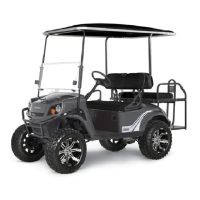
